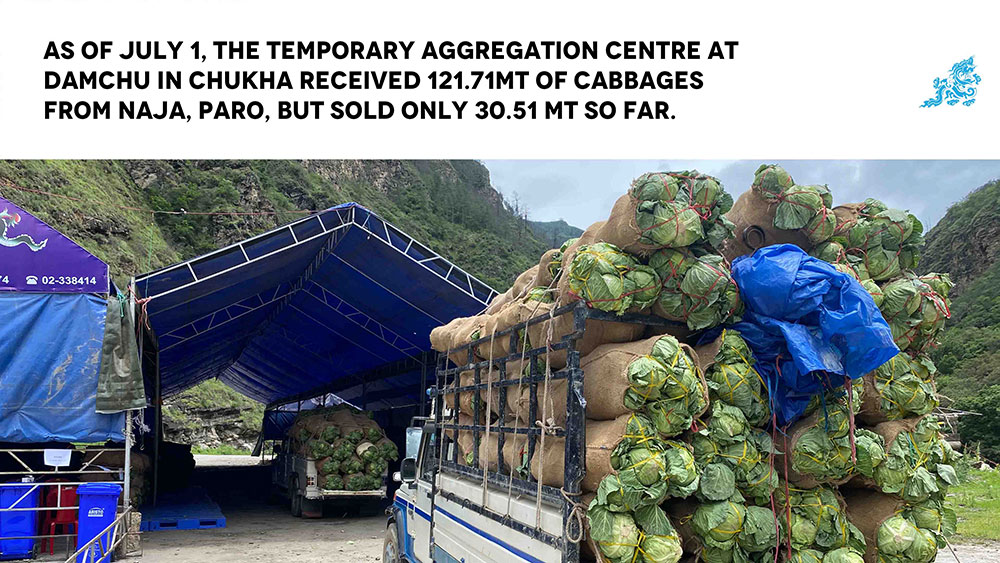Phub Dem | Paro
With sacks of cabbages piled, Damchu in Chukha has yet again become a cabbage hub. The agriculture ministry turned it into a temporary aggregation centre on June 29.
Farmers are bringing in bolero of cabbages, and the place is filling to its brim.
The centre receives 40 metric tonnes (MT) of cabbages from Naja gewog daily.
According to the centre’s team leader, Jamyang Lophyal, the Department of Agricultural Marketing and Cooperatives (DAMC) has set up a temporary centre to buy back and distribute cabbage, as there is a marketing issue due to the sealing of borders and lockdown in West Bengal.
He said that the interim measure would ensure a reasonable income for farmers during market distress until the government obtains export clearance for cabbage.
Although cabbage is grown for export, he said that cabbage is not included in the import list per the newly adopted ICE-GATE System of India. “The domestic capacity is minimal as compared to the volume of production.”
He said the government was in constant touch with the Indian government to address the export restriction issue. “The issue is expected to resolve any time soon.”
The agriculture ministry conducted a meeting yesterday to discuss a contingency plan to cater to the unpredictable market and remaining stock at the centre.
Jamyang Lophyal said a positive signal for the export to resume within a few days, after which Food Corporation of Bhutan will undertake procuring from source and exporting the vegetable.
The Embassy of India organised a virtual bilateral trade meeting yesterday to address and urgently facilitate Bhutan’s exports of key agricultural commodities to India, with focus on inclusion of seven crops.
The commodities include chillies, beans, cabbages, cauliflowers, carrots, peas, and soybeans.
An official dealing with sourcing and distribution at Damchu said that the team explored every corner of the country to sell the product, but the domestic market was limited.
He explained there were some demands from the southern dzongkhags, but it was difficult to facilitate as most places are under lockdown. “Roadblocks due to incessant rainfall are worsening the situation.”
The agriculture ministry is currently buying back cabbages at the approved Nu 15 kilogramme rate and distributing them to various domestic markets based on the demand.
However, as per the records maintained for the last three days, the domestic market ab-sorbed only about 25 percent of the supply.
Jamyang Lophyal said that the aggregation centre could receive 40MT a day per its handling capacity, and the centre could distribute about 10MT a day.
He said that the centre stocked the remaining 30 MT daily, which amounted to 91.2MT by the third day on July 1. “These stocks are vulnerable to damage as cabbage is highly perishable and it requires safe shipment from the point of production to the point of consumption at the earliest after the harvest.”
As of July 1, the centre received 121.71MT of cabbages from Naja and sold only 30.51 MT.
Meanwhile, farmers are worried.
They said if the government cannot help them export it within a month, the buyback scheme would collapse and run into losses.
A group of farmers from Zursuna said the centre was having difficulty marketing cabbages of two chiwogs from Naja.
They said that cabbages from Jabana, Dawakha, Lingshi and Chukha would enter the market any time.
Farmers are also unhappy with the government’s mode of intervention, as only eight households from each chiwog can sell their produce in a day.
The farmers have to take turns to transport cabbages to Damchu as per the list with gewog tshogpas.
A farmer, Penjo, sold 70 sacks of cabbages on July 1.
He claimed he could sell only half the produce in his garden. “The cabbages in my garden will be damaged by the time I sell them next time.”
He said exporting cabbage was not an issue in the past. “The issue would be resolved if it is included in the export list. The government should do something about it at the earliest. It is our only source of income.”
Wanakha and Zursuna tshogpa, Jampel Dorji, said farmers were disappointed with the selection procedure as every farmer wants to sell off their products.
He said that only 40 percent of cabbages from two the chiwogs of Wanakha and Tsendrugoenpa are sent to Damchu. “The remaining are left rotting in the field.”
Jamyang Lophyal said that the ministry placed a dedicated team in the field to study the urgency to harvest and regulate the supply to the centre.
He, however, said that the centre was not informed of any cabbages rotting in the field.
Last year, the government spent Nu 30 million on the cabbage buyback scheme. Sources claimed the government had to dispose of most of it, as there were no buyers.
Edited by Tashi Dema


